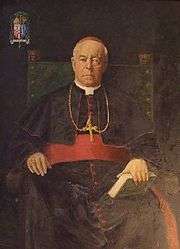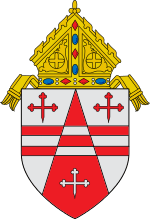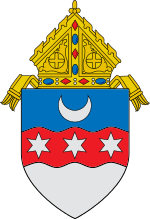Edward John O'Dea
Edward John O'Dea (November 23, 1856 – December 25, 1932) was an American prelate of the Catholic Church. He served as Bishop of Seattle from 1896 until his death in 1932; the diocese was called Nesqually until 1907.
His Excellency, the Most Reverend Edward John O'Dea | |
|---|---|
| Bishop of Seattle | |
 Edward O'Dea | |
| Church | Roman Catholic Church |
| Province | Portland in Oregon |
| Diocese | Nesqually/Seattle |
| Installed | June 13, 1896 |
| Term ended | December 25, 1932 |
| Predecessor | Egidius Junger |
| Successor | Gerald Shaughnessy |
| Orders | |
| Ordination | December 23, 1882 |
| Consecration | September 8, 1896 |
| Personal details | |
| Born | November 23, 1856 Boston, Massachusetts |
| Died | December 25, 1932 (aged 76) Seattle, Washington |
| Buried | Holyrood Catholic Cemetery Shoreline, Washington |
| Styles of Edward John O'Dea | |
|---|---|
 | |
| Reference style | The Most Reverend |
| Spoken style | Your Excellency |
| Religious style | Monsignor |
Born in Boston, Massachusetts, O'Dea was ordained to the priesthood in the Diocese of Oregon City in 1876. He was named the third bishop of the Diocese of Nesqually in 1896. During his time as bishop, O'Dea moved the episcopal see of the diocese from Vancouver, Washington to Seattle, and the diocese was renamed the Diocese of Seattle. He was also responsible for the construction of the present-day St. James Cathedral, which opened in 1907.
Biography
.jpeg)
Edward O'Dea was born in the Dorchester neighborhood of Boston, Massachusetts, to Edward and Ellen (née Kelly) O'Dea.[1] His parents were Irish immigrants, and his father traveled westward during the California Gold Rush in 1849.[1] The family later settled in Portland, Oregon, in 1866.[1] He attended St. Ignatius College in San Francisco, California, and graduated from St. Michael's College in Portland in 1876.[1] He continued his studies at the Grand Seminary of Montreal in Canada.
O'Dea was ordained to the priesthood by Archbishop Édouard-Charles Fabre on December 23, 1882.[2] Following his return to Portland, he served as a curate at the Cathedral of the Immaculate Conception. He served as private secretary to Archbishop William Hickley Gross until 1892, when he became pastor of St. Patrick's Church.[1]
On June 13, 1896, O'Dea was appointed the third Bishop of Nesqually, Washington, by Pope Leo XIII.[2] He received his episcopal consecration on the following September 8 from Archbishop Gross, with Bishops Jean-Nicolas Lemmens and Alphonse Joseph Glorieux serving as co-consecrators, at St. James Cathedral (now a proto-cathedral) in Vancouver.[2] When he took office, O'Dea was confronted with financial difficulties, including a $25,000 debt for the construction of the cathedral in Vancouver.[3] The name of the diocese was changed to the Diocese of Seattle on September 11, 1907, and the seat of the diocese was moved to Seattle's Capital Hill.[2] He dedicated St. James Cathedral later that year.[3] He guided the diocese through World War I and the anti-Catholic sentiment engendered by Initiative 49, a Ku Klux Klan-sponsored initiative to make parochial schools illegal.[4] His final accomplishment was the establishment of St. Edward Seminary in Kenmore in 1930.[4]
O'Dea died on Christmas Day in 1932, at age 76, two days after celebrating the 50th anniversary of his ordination to the priesthood. His final words were "God bless you all."[5]
Legacy
O'Dea High School, an all boys Catholic high school a block east from St. James Cathedral in Seattle was named after Bishop O'Dea.
References
- The National Cyclopaedia of American Biography. XIV. New York: James T. White & Company. 1910.
- "Bishop Edward John O'Dea". Catholic-Hierarchy.org.
- "Seattle". Catholic Encyclopedia.
- "Bishop Edward John O'Dea". Roman Catholic Archdiocese of Seattle. Archived from the original on 2009-12-08. Retrieved 2009-11-26.
- "Death Calls Bishop O'Dea". Seattle Daily Times (Volume LV, issue 361). December 26, 1932.
External links
| Catholic Church titles | ||
|---|---|---|
| Preceded by Egidius Junger |
Bishop of Seattle 1896–1932 |
Succeeded by Gerald Shaughnessy |

